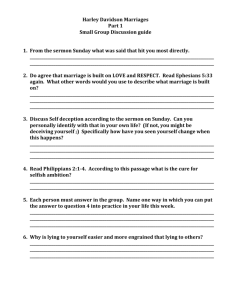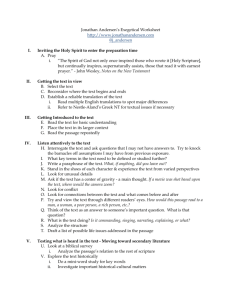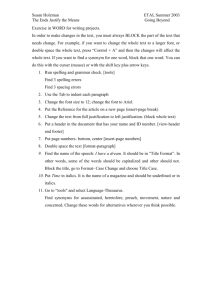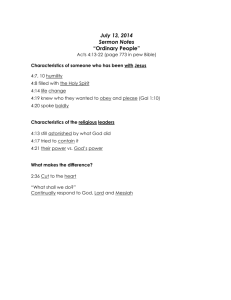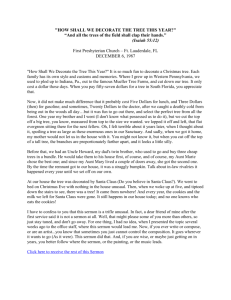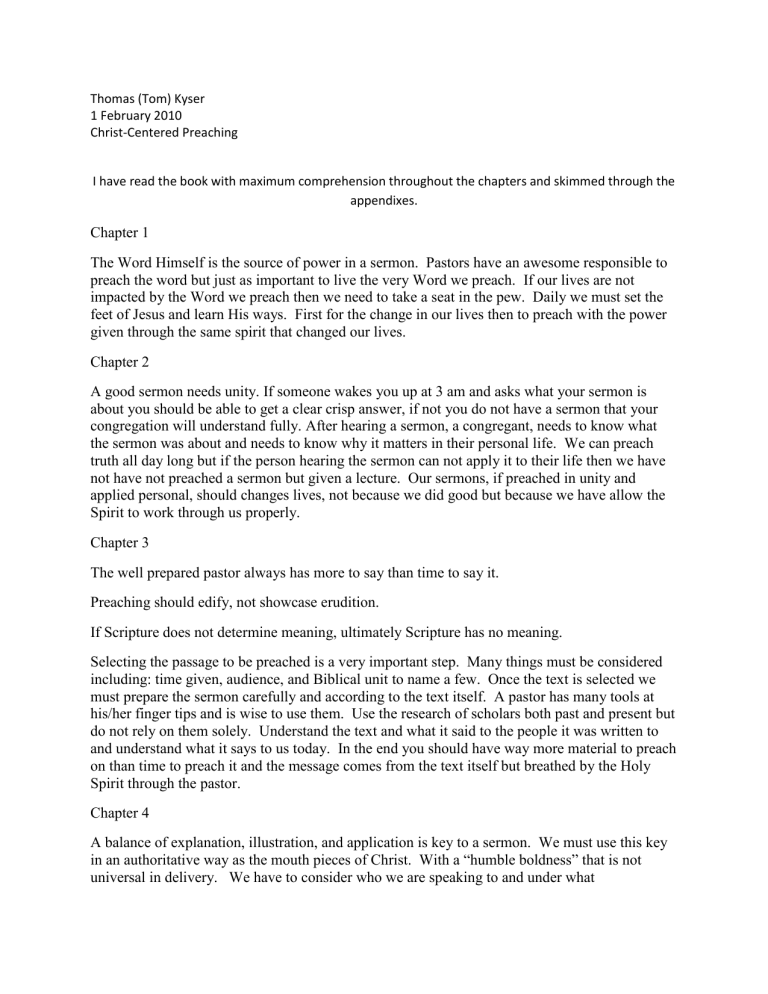
Thomas (Tom) Kyser
1 February 2010
Christ-Centered Preaching
I have read the book with maximum comprehension throughout the chapters and skimmed through the appendixes.
Chapter 1
The Word Himself is the source of power in a sermon. Pastors have an awesome responsible to preach the word but just as important to live the very Word we preach. If our lives are not impacted by the Word we preach then we need to take a seat in the pew. Daily we must set the feet of Jesus and learn His ways. First for the change in our lives then to preach with the power given through the same spirit that changed our lives.
Chapter 2
A good sermon needs unity. If someone wakes you up at 3 am and asks what your sermon is about you should be able to get a clear crisp answer, if not you do not have a sermon that your congregation will understand fully. After hearing a sermon, a congregant, needs to know what the sermon was about and needs to know why it matters in their personal life. We can preach truth all day long but if the person hearing the sermon can not apply it to their life then we have not have not preached a sermon but given a lecture. Our sermons, if preached in unity and applied personal, should changes lives, not because we did good but because we have allow the
Spirit to work through us properly.
Chapter 3
The well prepared pastor always has more to say than time to say it.
Preaching should edify, not showcase erudition.
If Scripture does not determine meaning, ultimately Scripture has no meaning.
Selecting the passage to be preached is a very important step. Many things must be considered including: time given, audience, and Biblical unit to name a few. Once the text is selected we must prepare the sermon carefully and according to the text itself. A pastor has many tools at his/her finger tips and is wise to use them. Use the research of scholars both past and present but do not rely on them solely. Understand the text and what it said to the people it was written to and understand what it says to us today. In the end you should have way more material to preach on than time to preach it and the message comes from the text itself but breathed by the Holy
Spirit through the pastor.
Chapter 4
A balance of explanation, illustration, and application is key to a sermon. We must use this key in an authoritative way as the mouth pieces of Christ. With a “humble boldness” that is not universal in delivery. We have to consider who we are speaking to and under what
circumstances. Chapell asserts that when we speak we are using the mouth of Christ and must use it with prayer and not abuse it.
Chapter 5
As a rule of thumb, expositors owe no more to explanation than what is necessary to make their points clear but owe no less than what is necessary to prove their points.
Share the fruit, not the sweat of exegesis labor.
When explaining the text we need to keep it simple. There is no need to explain more that necessary to make clear the point you are trying to make. The exegesis we use should be like underwear, always worn but never showed or as the Chapell words it, “Share the fruit, not the sweat of exegesis labor.”
The exegetical outline for every pastor should be about the same but the Homiletical idea will almost never be the same. We all preach to different people at different places but the outlining should be the same. It should be concise and to the point, the singular main point of the sermon.
The sermon outline helps keep you on point and progressing in a general direction. The keys to an outline is unity, clarify and progression.
We are a visual people, especially in the 21 century. A preacher needs to be able to, like Christ, paint a beautiful picture with his/her words. When used in a balanced supportive natural, illustrations can go a long way to bridge the gap of what the hearer reads in the Bible, to why it is important to them. They help clarify but more important motivate the listener.
Application is the key to a sermon. People need to know what you are saying means to them in their lives where they are. All the other part of the sermon can be fantastic but if the person whom you are speaking to does not understand how it will impact their lives it is a failed sermon.
People who call themselves by the name of Christ do not look much different from the world because they do not know how the Word applies to them.
Say what you are going to say, say it, say it again. This is a great point and loved the fact that it was used in this book. As stated in class every sermon needs a smooth take off and landing.
You have to bring the people in and give them a reason to listen to you, tie your points together neatly and bring everything together. When you start, grab their attention and when you end, end.
Preach Christ and him crucified. The grace of God through the remediation of man by His Son is through the Bible. A sermon ALWAYS needs to be centered on Christ. Sermons that only address our fallen condition without Christ are just self helps that do not work. The “be” sermons tell us to do something that without Christ we are not capable of and needed to be recentered to the only source that can help us to “be.”


![[5] Dec of Ind + Sermon on the Mount [5] (3)](http://s3.studylib.net/store/data/025212179_1-d74b0683fd17b6341e937ee0a9904117-300x300.png)
